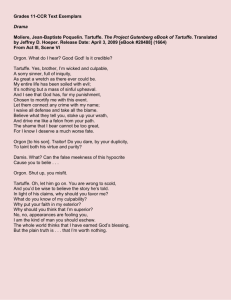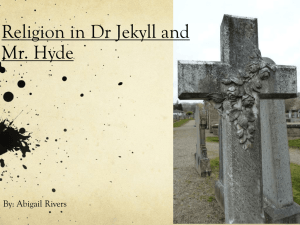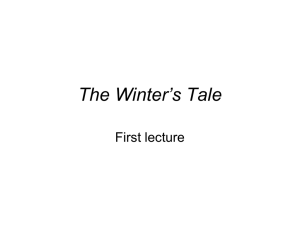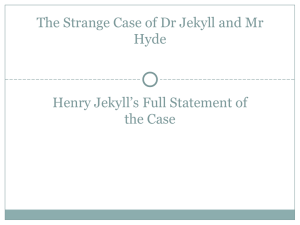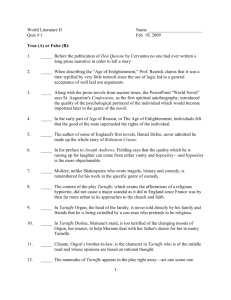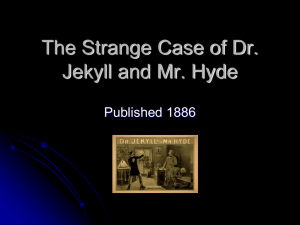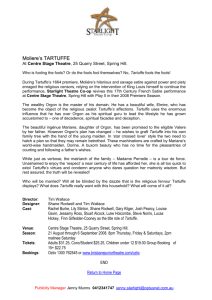Michael Christie's Writing Samples Key p.2 – p.4: “Tartuffe Action
advertisement
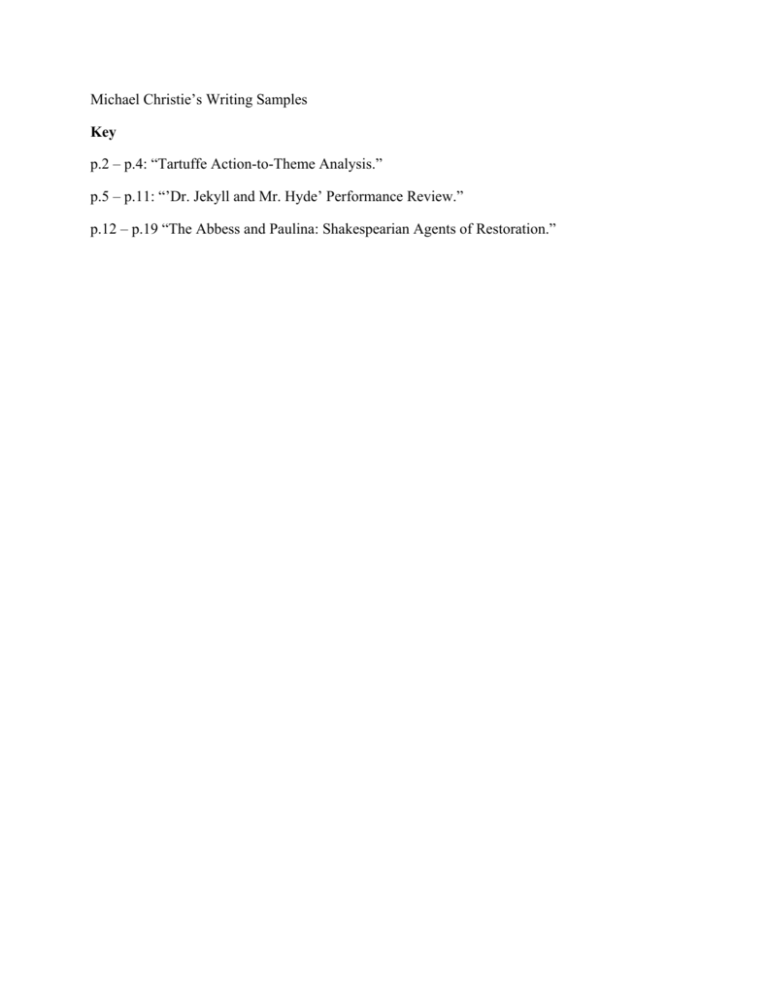
Michael Christie’s Writing Samples Key p.2 – p.4: “Tartuffe Action-to-Theme Analysis.” p.5 – p.11: “’Dr. Jekyll and Mr. Hyde’ Performance Review.” p.12 – p.19 “The Abbess and Paulina: Shakespearian Agents of Restoration.” Mike Christie Tartuffe Action‐to‐Theme Analysis When plotting the sequence of actions in a play, the first beat that is encountered is the closing beat, which literally is the very last action that occurs in the play. The closing beat in “Tartuffe” occurs in 5.7.97‐102, when Orgon tells his family that they shall go to the King immediately, kneel before him, and “express the gratitude which all are feeling.” Also, Orgon states that afterward they will see that Valere and Mariane are married –definitively ending the last line of conflict in the play. The next beat to define is the climax, which is the highest moment of dramatic tension in the play. The climax in “Tartuffe” occurs in 5.7.40‐2, when the Officer reveals that he intends to arrest Tartuffe and not Orgon. The arrest of Tartuffe is the climax because virtually every character in the play, and perhaps everyone in the audience, thought that Tartuffe had triumphed over Orgon and his family. However, with the inclusion of the deus ex machina character of the King, which shall be explained later on, the main conflict of the plot is able to reach its climax. The next beat is the attack, which signifies the moment when the plot of the story is realized and the characters (consciously or subconsciously) experience a chain of events (rising action) that inevitably reaches its climax, and then is resolved up to the closing beat (period known as the dénouement). The attack in “Tartuffe” occurs in 3.7.43‐4, when Orgon tells Tartuffe that he will legally appoint him as the only son and heir to the family’s estate and fortune: “Come, we’ll go draw up the deed.” This moment arguably is the best‐defined point of attack because it adheres to the main plot line of the play, which is that Tartuffe tries to con Orgon in order to steal his money and possessions. Tartuffe befriended Orgon for the sole purpose of stealing from him, so when Orgon signed over everything he owned to Tartuffe the con artist could begin to push the family out of what was once legally theirs. Another place the attack could be placed would be the moment when Orgon gives Tartuffe Mariane to be his bride, in 3.6.52‐4. Although this moment could be an attack in a production of “Tartuffe,” it does not follow the main plot line because Tartuffe is not after Mariane –he is after her family’s estate. While Tartuffe would have presumably been paid a dowry for marrying Mariane, at that moment he did not become the heir to Orgon’s holdings so he could not begin to seize control and backstab Orgon with his friend Argas’ strongbox that held incriminating documents. The final beat that concerns the plot is the opening beat, which, conversely from the closing beat, is the first unit of action in the play. The first thing that happens when the lights come up and the play starts is that Madame Pernelle calls to her servant Flipote in a huff and tells him that she wants to leave Orgon’s house. There are also other theatrical beats that contribute to the plot lines, and also the larger themes of the play. The major anagoresis, or discovery, of the play is when Orgon (the protagonist) in 4.6 discovers that Tartuffe is a fraud who thought he was gullible and only befriended him to steal his estate. The major peripiteia, or reversal, in the play arguably also occurs in 4.6 after Orgon has eavesdropped on Tartuffe and Elmire’s conversation while under a table. Instead of professing his undying love for Tartuffe as he did in the previous scenes, Orgon formally denounces and threatens Tartuffe for deceiving him. Finally, the maguffin, or hook, of the play could certainly be the antagonist Tartuffe, who is a hypocrite that pretends to be moral in order to become rich and powerful and in effect keeps the audience’s aesthetic distance great throughout the play due to such blatantly hypocritical actions. Moliere’s comedy explores many different themes that are revealed through truthful ideas that are based within the overall conflict. Perhaps the most important theme of the play is ironically one that Moliere nearly diminished. The idea that a monarchy can be easily deceived (in this case by religion) and can lead its citizens to certain demise was a subversive and dangerous notion to advocate. After facing harsh criticism from King Louis XIV’s catholic ministers who delayed the play’s production and threatened his banishment, Moliere added the deus ex machina of the King in order to “prove” that neither he nor his play harbored any such seditious or radical feelings. Even though Orgon represents an inept king who is manipulated by religious influences (Tartuffe), while his people suffer (the family), the deus ex machina falsely states that the monarch is an all‐knowing, extremely intellectual person who cannot be deceived by any influence. This also relates to the theme of patriarchy and how it should be regarded as fallible, just as Elmire and other family members prove when they observe how Orgon is misguided. Yet, as the King’s inclusion in the plot somewhat reversed Moliere’s meaning toward the monarchy, so did Elmire’s dialogue in 3.4.13‐4 when she proclaimed that it is wrong for a woman to go against her husband. Another theme in the play is true love, and how it can never be hindered. In a comedy, a popular line of conflict is to have two young lovers blocked from true intimacy due to an older character. In this case, Moliere used Tartuffe as a blocking character to Valere and Mariane’s engagement, though as all comedies inevitably end in marriage, Tartuffe (and to some extent Orgon) cannot diminish the lovers’ spirits. Finally, one of the last themes in “Tartuffe” is rationality and how it can stabilize the chaos. Cleante, the embodiment of reason, provides wise adages to the audience, such as not all religion is corrupt, logic trumps blunt action, and (perhaps regrettably by Moliere) that the monarch is a mercifully benevolent leader. Michael Christie Performance Review: Dr. Jekyll and Mr. Hyde On a cold and bleak fall night people congregated at the City Theatre to watch a preview performance of Jeffrey Hatcher’s Dr. Jekyll and Mr. Hyde, an adaptation of Robert Louis Stevenson’s 1886 classic novella The Strange Case of Dr. Jekyll and Mr. Hyde. Robert Louis Stevenson was a poet, essayist, and writer of travel sketches. Plagued by poor health for most of his life, Stevenson got the idea for his novella while having a nightmarish fever dream. Set in 1883 during the later stages of the Industrial Revolution, the story is roughly about a man, Dr. Henry Jekyll, who is being investigated by authorities for his relation to a friend, Mr. Edward Hyde, who is the prime suspect in many gruesome murder cases. The two friends, at odds because of the investigation, fight to gain supremacy over each other; yet it is ironically revealed that total victory is unobtainable because their relationship is chillingly closer than first expected. Stevenson referred back to some of his short stories that dealt with the duality of the human character in order to make his startling visions coherent and adhere to a plot structure. Deacon Broadie, a play Stevenson wrote with W.E. Henley, was about a good and moral man who turned unrecognizably evil once the sun went down. The script, however, had many holes in it and perhaps did not effectively captivate audiences because it lacked a fundamental theme to which people could relate. Stevenson’s novel ended up being introspective narrative about the complexity of the human mind and its constant vacillating in and out of psychosis. It was written years before Freud or Jung published their formal findings on psychoanalytic theory, which actually supported the plurality of man’s nature rather than its duality. Nevertheless, Stevenson’s written subject matter was certainly considered advanced for its time. The Strange Case of Dr. Jekyll and Mr. Hyde, according to its updated introduction, was printed as a book that cost one shilling, instead of in magazine installments, and soon sold about forty thousand copies in England alone. The book generated a wide amount of discourse and debate within religious, political, and social forums because of its somewhat controversial statements about the inherent contradictions of man and also simply because of its terrifying storyline. Stevenson, as evidenced by the cultural impact he created, has inspired hundreds of “Jekyll and Hyde” adaptations that stray quite far from his original. Jeffrey Hatcher acknowledges Stevenson’s everlasting influence on literature and drama and yet, in a sense, sets out to adapt “Jekyll and Hyde” in a way that examines the playwright’s position on the duality of the human character with objective lenses that specifically focus on each character’s good and bad tendencies. This interpretation of Stevenson’s text aims to blur the lines of compassion that audience members feel towards the two title characters. About halfway through the play audience members are allowed to see a more personal (and arguably “humane”) side of the malicious “Edward Hyde” through a relationship with a woman, and at about the same time “Henry Jekyll” reveals his plan to abolish the nature of man (notably, its evil nature) by creating chemical concoctions that could inhibit immoral desires and thus create human beings that are serene and good‐hearted. Ironically, when Jekyll experiments on himself to find that perfect chemical mixture he ends up discovering the exact opposite. Jekyll’s detestation of the duplicitous nature of man, of which he primarily blames “the soul,” is a key factor that leads to the audience’s negative perceptions of his character. To solidify this motif of duplicity, Mr. Hatcher has four characters (including females, whom he has added to the traditionally male script) portray the role of “Henry Hyde” in addition to their main roles. Mr. Hatcher’s Dr. Jekyll and Mr. Hyde premiered at the San Jose Repertory Theatre on May 10th 2008, and received generally positive reviews. Many theatre critics praised Hatcher for his “sophisticated” mystery plot that is encapsulated by the fascinating gloom of London during the later years of the Industrial Revolution. Now the focus shifts to Pittsburgh, a former industrial city that, too, is at a sort of crossroads developmentally, and the City Theatre, of which Hatcher is its most produced playwright, where the commercial magic of “Jekyll and Hyde” will be tested and, hopefully, explored and interpreted in a new way that encourages audience members to existentially ponder about the good and bad in human nature. In the lobby of the City Theatre is a flat screen TV that broadcasts information about the design processes of the show. For scenic designer Tony Ferrieri, Claude Monet’s “The Waterloo Bridge” (1903) inspired him to paint images on the backdrop of the set that depict a dismal scene of factories and overpopulated towns that are covered by a pall of industrial smog. Once inside the theatre, it even seems that Ferrieri has painted faintly monstrous faces within the pollution that furthers the theme of the danger (and perhaps inherent evils) of progress in the play. The stage of the theatre itself is in a proscenium setting. Upstage there is a row arcades that supports a catwalk, which has two entrances and exits on both of its sides and a spiral staircase. Different wall and door flats are rolled on stage and fit within the arches of the arcades, which can be distracting if not facilitated smoothly. As this was a preview performance, there were various things that went wrong on stage during the show, including occasional collisions involving the wall and door flats. One scenic blunder occurred when “Dr. Jekyll” (David Whalen) slams a door and causes part of the front panel to break off. The actors were quick to adapt to the sudden change, as “Elizabeth” (Melinda Helfrich) let out an extra scream as the panel fell to cancel the sound and “Hyde 3” (Kelly Boulware) made sure that he could not be seen on the other side of the door. Yet it was revealed later on that the door was supposed to be “broken” by an axe, and thus the panel lost its theatrical effect on audiences when it was intentionally broken later on. Costume design also plays a crucial part in the story. Renowned costume designer and Carnegie Mellon professor Susan Tsu was influenced by Victorian and Steampunk Goth fashions, which, although they are from different periods, have stylistic similarities that help adapt the appearance of the characters for a twenty‐first century audience. Many of the characters wear costumes that act as mirrors into their own personalities. Perhaps the most elaborately dressed was “Elizabeth,” who actually was a minor character Hatcher added as a potential love interest for “ Dr. Jekyll” and “Mr. Hyde.” The wardrobe of “Dr. Jekyll,” however, appears insubstantial and generates some confusion. “Dr. Jekyll” ends up being portrayed as a duplicitous fiend who eventually falls from grace, and yet he constantly wears prominent colors such as gold, deep blue, and even white fabric that symbolize his power, intellect, and arguably his innocence. Even though “Dr. Jekyll” could be seen as “a wolf in sheep’s clothing,” there might not have been a firm directorial decision as to whether or not that metaphor should have been upheld in the show. The same could be said for the costume design of three of “the four Hyde’s,” who, when they switch (often at a moment’s notice) from their main roles, simply put on a top hat or cloak and walk with a cane. In some early scenes it was vague as to whether or not there were multiple “Mr. Hyde” characters, like Mr. Hatcher intended, or if the supporting characters simply were recalling their impression of “Mr. Hyde” to the audience and each other. This was a recurring “gray area” of the production that truly hindered the overall communication of Mr. Hatcher’s theme. Sound Designer and Carnegie Mellon Professor Joe Pino, although he was not included in the lobby display, certainly left a mark on audiences during the show with his sharp and thunderous sound cues. Many times audience members were jolted out of their seats by brief and shrill orchestral vamps. These cues might have been overly done to create distancing effects meant to further estrange the audience from forming any clear‐cut perception of the action that had just taken place. The final piece of information displayed was about the lighting. Lighting designer Christian DeAngelis was inspired by “1940‐50’s film noir cinematography,” which has a proclivity for light, shadows, and atmospheric haze. DeAngelis clearly had the most fun with casting shadows over characters, especially “Dr. Jekyll” and “Hyde 3,” in order to accentuate their duplicitous nature. Perhaps the only thing the set lacks is literal smog provided by fog machines, which would have completed the seedy atmosphere that the script dictates. Lighting, unfortunately, was to blame for the largest technical error that ruined the theatrical experience of the night. Late in Act I it appeared that some lights on the grid were flickering unintentionally. This flickering soon intensified and most of the lights on the grid went out, which ironically caused the delivery and gravity of a line spoken by “the Maid” (Sheila McKenna) to be nearly lost to the audience. “The Maid,” at the climax of Act I., recounts the murder of “Sir Danvers Carew” (here played by Martin Giles) by “Hyde 3” (Kelly Boulware) from the catwalk as it is replayed in front of the audience below. “The Maid” utters, “When I had my wits about me, I pulled open the sash and called for the constable. I’m sorry. The better me would have called out sooner…but the bad in me…wanted to watch.” As she utters this line “Hyde 3” repeatedly bludgeons “Sir Danvers Carew” with a cane until it snaps in two and the act ends. Attraction to gore is a theme that the play addresses towards the audience itself, which makes for an introspective, almost meta‐theatrical dialogue because for the first time audience members are forced to question how they could watch and tolerate such violence being performed on stage. Even though the murder and other brutal scenes appalled some audience members, there is no question that the commercial appeal of the show revolves around the depiction of nefarious acts that go against all standards of society. Tracy Brigden, the director, clearly staged this scene as one that would be a lynchpin for the entire piece because it partially helps answer the question of why this play should be performed today. On this night, instead of a dialectical moment, audience members (and actors) are literally left in the dark as “the Maid” delivers her final lines and Ms. Brigden herself, from the back of the theatre, shouts that technical difficulties have occurred and that Act I. has officially ended. The light cues are never fully restored for the rest of the performance. As most of the audience exits the theatre after the final curtain, Ms. Brigden remains to talk with some members of her artistic team that sit with her at the back of theatre audience. One notable guest in the group is actually Jeffrey Hatcher himself, who attended an earlier dinner held at the theatre in his honor. Mr. Hatcher seems relatively relaxed and even smiles occasionally, as Ms. Brigden appears to explain to him what caused the technical errors. Mr. Hatcher’s calm mood is warranted: despite the unprofessional errors hardly a seat was vacated between intermissions and, perhaps more importantly, his depiction of the duplicity of mankind has been colorfully interpreted. However, the show does not go a step farther and address how human nature can be genetically “transformed” to agree with a changing society’s ideals. Arguably the most important aspect of the show, aside from all the design process, has to be the work of Ms. Brigden and her artistic team. “The altering of human nature by transforming societies” is an interesting theme that relates to twenty‐first century audiences because often we are forced to suppress our inherent beliefs and attitudes just in order to live and function in society. The debate over genetic engineering, an issue that is prevalent in current events and is mirrored in the play, serves as an example of how a groundbreaking discovery can either involve or alienate people. In the lobby, before the show, a City Theatre volunteer is asked why he thinks the Mr. Hatcher’s adaptation is relevant. The volunteer, perhaps an avid “Trekkie,” replies that new technology is often a useful tool that quickly can become a boon to the people who take it for granted, which certainly is a plot line of many Star Trek episodes. The volunteer recalls Dolly the sheep, the first cloned mammal, as an example of a relatively recent genetic experiment that could create potential problems for the future. The volunteer’s interpretation of why the play should be staged today is interesting because it would have at least provided a connection to the genetic altering of a living thing, yet unfortunately anything that resembles that is unrealized in this production. Ms. Brigden all but forsakes this dialectical opportunity. Instead, hardly any dramatic theory is integrated into the plot to enhance David Whalen’s intricately worded dialogue, which unsupported comes off as uninspired and commonplace. Besides the set design, it seems like there is a scant amount of signs (either as props or emphasized bits of dialogue) that do not signify this concept of transforming societies or genetic alteration. Instead, “Dr. Jekyll” appears as a stereotypical mad scientist who mixes and readily consumes potions and occasionally makes profound statements that seem to originate from out of thin air. Without any modern link that can be made to emphasize that human nature is at risk of being altered by progressive societies, the production seems dangerously redundant and far less “sophisticated.” In conclusion, the City Theatre’s production of Dr. Jekyll and Mr. Hyde does meet its original goal of having its audiences speculate about the good and bad in human nature and yet audiences may still crave for more. It is important to remember that this show is in previews and can still substantially supersede its original goal if the direction focuses less on the common imagery and language that simply contrasts the good and evil within humans (such a concept itself is not incredibly novel or foreign to people) and instead explores the social conditions and the psychological patterns that create the duplicities themselves. The show is shaping up to be an enticing display of the beautiful and gruesome shades of the human character and has the potential to develop its intricate subject matter so that audiences hopefully are not only entertained by spectacle alone, but also are part of a dialectical discussion about the existential tendencies of human nature. Works Cited Hatcher, Jeffrey. Dr. Jekyll and Mr. Hyde. New York: Dramatists Play Service Inc., 2008. Stevenson, Robert Louis. The Strange Case of Dr. Jekyll and Mr. Hyde. New York: The Limited Editions Club, 1952. Michael Christie The Abbess and Paulina: Shakespearian Agents of Restoration The Abbess and Paulina, from The Comedy of Errors and The Winter’s Tale, respectively, are significant because Shakespeare employs them as agents of restoration to attempt to correct common social conflicts that his plays dramatize. The Abbess and Paulina have unique jobs because they personally operate within distinct Shakespearian genres: comedies and romances. Russ McDonald, in his book “The Bedford Companion to Shakespeare: An Introduction with Documents,” individually defines these terms: “Comedy…moves towards a happy ending and implies a positive understanding of human experience…problems can be solved. Romances…are fantasy plays…[that] force us to examine and evaluate our need for satisfactory closure” (McDonald 81‐96). The Abbess and Paulina help develop and present these requirements through a variety of ways. The Abbess, a wife and mother of two whose real name is Emilia, comes out of obscurity to serve as a deus ex machina that sides with her son Antipholus of Ephesus against his furious wife Adriana and successfully pleads to Solinus, the Duke of Ephesus, to not execute her husband Egeon. Paulina, a widow who is childless and a crucial supporting character, defends Hermione, Leontes’ wife, against persecution, acts as a doctor for Leontes’ sickened heart and mind, and notably reaffirms romance as a tragicomedy when she accepts the death of her husband Antigonus. Both characters, which Shakespeare perhaps intentionally has made female, not only change the course of their respective plots but also undergo change themselves as a result. The Abbess first appears very late in The Comedy of Errors’ plot (Act V, Scene I –the final scene of the play) when Antipholus of Syracuse and his servant Dromio flee from Adriana, who wants to detain them for being mentally unstable, and they hide in the Catholic priory. Adriana is soon confronted by the Abbess and is accused of not being “rough enough” with her husband when it comes to his infidelity, which the Abbess quickly suspects might be the problem in their relationship. When Adriana states that she has, in fact, been quite persistent in her inquiry into Antipholus’ personal life, the Abbess interrupts her: “It seems his sleeps were hindered by thy railing…Thou sayst his meat was sauced with thy upbringings. Unquiet meals make ill digestions…Be quiet and depart. Thou shalt not have him” (5.1.72‐ 113). In this statement the Abbess restores the power of the patriarch in society by accusing Adriana of upsetting her husband’s bodily humours, which were cited as having the most effect on a person’s health in Elizabethan England. In the eyes of the Abbess, Antipholus has been behaving oddly because Adriana has bereaved him of his warm, masculine humours by keeping him up at night with her constant prodding. The metaphor of food also is recurring in the play, with “the Antipholii” constantly being told that they are late for dinner. Food no longer seems enjoyable or necessary to them because of the confusion and chaos over the mixed identities and also Antipholus of Syracuse’s infidelity. Even though the Abbess’ speech through a modern lens can be interpreted as being socially backward, she does assess part of the play’s overall conflict and then proceeds to diffuse it –which thus allows the play to have a quick and painless resolution. It is important to remember that the Abbess does not condone extramarital affairs; rather she sees Adriana as the cause of Antipholus’ infidelity and thus upbraids her for it. The Abbess proves that not all restoration is positive and progressive and that often a return to the status quo is not desirable or advantageous for everyone in a play; yet it is necessary to end a Shakespearian comedy. The Abbess should be compared to a skillful lawyer when she professes Egeon’s innocence to Solinus, Duke of Ephesus. Like clockwork the Abbess links together the estranged relationships between Egeon and the pairs from Syracuse and Ephesus in a masterful manner: “Whoever bound him [Egeon], I will loose his bounds, and gain a husband by his liberty. Speak, old Egeon, if thou hadst a wife once called Emilia, that bore thee at a burden two fair sons” (5.1.340‐4). This is ultimately the statement that sets the comedy up to be joyfully resolved. Here the Abbess establishes herself as a physical embodiment of freedom because she knows that she is the key to Egeon’s figurative chains. The final piece in the puzzle, Emilia was the last character in the plot whose existence was in question. Her appearance validates the fact that in Shakespeare’s comedies no character can die or be seriously harmed. Thus, once Egeon is freed he will not only gain his liberty, but also his long‐lost wife. Like any seasoned lawyer, the Abbess lessens the gravity of Egeon’s crime by adding a personal touch to her argument: “Renowned Duke…go with us into the abbey here…and hear…all…that by this sympathized one day’s error have suffered wrong. Thirty‐three years have I but gone in travail…Go to a gossips’ feast, and joy with me. After so long grief, such festivity” (5.1.395‐408). Here the Abbess logically plays to the emotions of Solinus as she invites him and everyone else to the priory for a feast (perhaps an inside comment by Shakespeare on the benevolence and tolerance of Catholicism). There, as the reader could be led to suspect, the Abbess will further play to the Duke’s heart as she tells him how just one, miniscule case of treason actually helped end her thirty‐three years of inconsolable doubt and suffering. It is also significant that the image of feasting has been restored to have very positive connotations, because now the Abbess contends that companionship and constructive discussion can resume at the dinner table. Readers, as noted by McDonald, can thus once again interpret the human experience in a positive manner after the Abbess triumphs in her quest. The speech from 5.1.340‐4 is also the first time in the play that the Abbess’ name is revealed. Some might argue that once the Abbess is revealed as Emilia she instantly becomes a developed character because she is inextricably linked to the storm that separated her from her family and also to the years she has lived in solitude with only prayer to ease the strain on her heart. However, the Abbess should not be considered a developed character because she randomly appears in the plot to serve as a deus ex machina. Also, none of her development technically occurs within the timeframe of the play, and thus an audience is never able to track how she progresses as a character. The Abbess is a very powerful, effective, and influential, yet she should only be regarded as such because Shakespeare specifically crafted her to have those qualities in order to nicely and conveniently conclude his story. Ironically, Abbess is greatly changed by what she restores because she unknowingly reveals her own family to herself in a happily comedic fashion. In this regard she is different from Paulina, who arguably knows what the consequences of actions taken as an agent of restoration entail. Paulina appears in The Winter’s Tale early on and immediately tries to save the plot from complete chaos after Leontes imprisons his wife Hermione, banishes his newborn daughter, makes his son deathly ill, and causes his lord Camillo and Polixenes to flee from Sicilia. Paulina enters Leontes’ courtroom holding his newborn daughter and pleading with him to dispel whatever ails him. “I come to bring him [Leontes] sleep. I do come with words as medicinal as true, honest as either, to purge him of that humour that presses him from sleep. Myself your loyal servant, your physician…I come from your good queen” (2.3.54‐8). In this passage Paulina establishes herself as Leontes’ doctor and makes it known that she desires to expel his unwarranted, negative thoughts against Hermione and thus avoid any further damage to the situation. Like the Abbess, Paulina calls attention to the misaligned humours of the patriarch and state that they have kept him from sleeping and having lucid thoughts. Paulina also makes it clear that much of her speech throughout the play is meant to be poignant and have healing effects. Even though Leontes seems immune to Paulina’s prophetic and poignant words, she does not allow him to completely dismiss her –even after she receives death threats. Holding the newborn out for Leontes and his somewhat devious lords to see, Paulina explains how Polixenes and Hermione could not have conceived her: “The pretty dimples of his chin and cheek, his smiles, the very mould and frame of hand, nail, and finger… So like to him that got it…’mongst all colours no yellow in’t” (2.3.99‐107). Here Paulina, the knowledgeable physician, points out all of the physical features the newborn shares with Leontes. The description of the hand, a popular symbol in the play, is significant because Paulina might want to show that the newborn is an innocent offspring of Leontes and would rather take his hand in familial embrace rather than have the desire to overthrow him with it, as he most likely believes. Paulina points out its features because Leontes began to deny that he had fathered the child, perhaps due to the fact that Polixenes had been staying in his palace for nine months (the duration of a human pregnancy). Paulina importantly states that the newborn does not have a touch of yellow, a color associated with jealousy, in its skin. Therefore, Paulina remarks, the baby would be yellow if Leontes and Hermione suspected or knew that Polixenes helped conceive the baby. Paulina’s perception of the human form, however, can be considered akin to beliefs held in witchcraft and thus she is valued even less in society. At the beginning of Act V, sixteen years after the tumultuous events left three characters dead and one banished, the plot comes full circle once again and ends in Sicilia. It is fitting, then, that the first line Paulina utters serves to remind Leontes of the crimes he committed: “Too true, my lord. If one by one you wedded all the world, or from the all that are took something good to make a perfect woman, she you killed would be unparalleled” (5.1.13‐6). Paulina says this because Cleomenes, a lord to Leontes, suggested that Leontes should remarry quickly and produce an heir to his throne before he dies. Paulina, appalled that Leontes should ever try to replace Hermione, states that no one in the entire world could ever compare to her. Leontes is utterly shaken by the words “she you killed,” and is once again thrust back into immeasurable suffering and guilt that he likely has tried to rid himself of for years. Paulina, unlike the Abbess, proves that she is forever loyal to the matriarch in society, which in a way hints that her restoration might prove to push the status quo further down the path of reform before it can be fully resumed again. Paulina, also like the Abbess, relies on her religious faith to assure her that the gods’ prophecy has yet to fully come true and that the kingdom will not be left without an heir: “There is none worthy respecting her that’s gone. Besides, the gods will have fulfilled their secret purposes. For has not the divine Apollo said…that King Leontes shall not have an heir till his lost child be found” (5.1.35‐40)? Plot‐wise, this important statement sets up the return of Perdita to her homeland and Leontes’ approval of her marriage to Florizel, which ultimately ends the feud with Polixenes and the uncertainty over the kingdom’s future. Despite the sorrow and heartache around her, Paulina’s emotions remain controlled and her language is calculated and commanding. It seems as though Paulina is anxious for the arrival of Perdita for another reason, though, and this begs the question: did Paulina know that Hermione would “rise from the grave?” There are various moments of doubt throughout Act V that could easily make the reader wonder if Paulina secretly knows that Hermione will come back from the dead, or rather that she has been alive all along. Regardless of what Paulina specifically might know, it is clear that she is quite calm and easily accepts Hermione’s powerful return to the plot. Paulina utters a harsh warning to Leontes before she allows him to go to Hermione: “Start not. Her actions shall be as holy as you hear my spell is lawful. Do not shun her until you see her die again, for then you will kill her double” (5.3.104‐7). Here Paulina completely puts Leontes in his rightful place and warns him that he should not shun Hermione until she dies (technically, for the second time). The meaning of “her double” has been interpreted literally and figuratively, but regardless of specifics Paulina obviously does not want Leontes to repeat his sins and destroy Hermione’s life again. Paulina’s actions are nothing short of admirable and empowering, and she, unlike the Abbess, wants Hermione to have greater power and influence once she is welcomed back into the kingdom by her husband Leontes. Finally, Paulina briefly shows that she is partially unaware of what the play will ultimately be restored to and as a result she helps prove McDonald’s assertion that romances are tragicomedies. After Hermione addresses Perdita, whom she had never really gotten to know, Paulina utters a bittersweet line that captures an accurate view of the unjust form of restoration that the play concludes with: “Go together, you precious winners all; your exultation partake to everyone. I, an old turtle, will wing me to some withered bough, and there my mate, that’s never to be found again, lament till I am lost” (5.3.131‐ 6). Here Paulina expresses both intense happiness and sadness, as she is glad that Hermione and Perdita will bring love and warmth to the kingdom again, and yet she is despondent because her husband Antigonus could not be brought back from the grave. Even though Leontes forces Camillo to take Paulina’s hand in marriage, that ending seems far too contrived. Paulina even refers to herself as “an old turtle,” which symbolizes faithful love –meaning that she will never be able to love another as she did Antigonus. Thus Paulina, in a very rare moment, exposes a profound “weakness” to her character that serves to bolster McDonald’s claim that romances have unsettling endings in order to force a discussion over whether or not a complete resolution to a romance is appropriate or needed. In conclusion, the Abbess and Paulina are notable Shakespearian agents of restoration who operate differently and have ulterior motives due to the fact that they belong to separate genres of drama. Often, it is shown that even they are susceptible to changes once they bring about the restoration and conclusion of their respective plots. Yet the Abbess and Paulina are truly remarkable not only because they work against seemingly insurmountable odds to solve complex and often heated debates, but also because they do so as liminal characters in a patriarchal society. They are remarkable and unique because they are women, and therefore not only do they have to fight for restoration but also for their right to be heeded by others. For Shakespeare to give this power to women, even if it might have been unintentional, certainly could make him appear as a progressive agent of restoration who had a better view of what the society he wrote for should strive to become. Works Cited Greenblatt, Cohen, Howard, and Eisamen Maus. “The Comedy of Errors.” The Norton Shakespeare Comedies Second Edition. New York: W.W. Norton & Company Inc, 2008. Greenblatt, Cohen, Howard, and Eisamen Maus. “The Winter’s Tale.” The Norton Shakespeare Romances Second Edition. New York: W.W. Norton & Company Inc, 2008. McDonald, Russ. “Theatre a la Mode: Shakespeare and the Kinds of Drama.” The Bedford Companion to Shakespeare: An Introduction with Documents Second Edition. Boston: Bedford/St. Martin’s, 2001.
